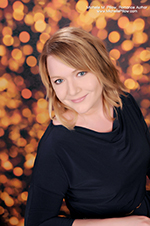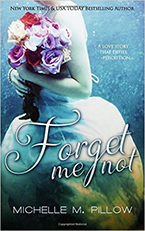An interview with New York Times and USA Today bestselling author,
Michelle M. Pillow
Arranged Marriage Perfect Juxtapose in Gothic Twister
 How long have you been writing professionally?
How long have you been writing professionally?
My first paranormal romance was published in 2004 under the title The Mists of Midnight. It has since been revised and was just re-released under the title Forget Me Not.
How many novels have you published?
Over 100.
Wow. What’s your secret for producing so much? Do you write on a specific schedule?
I wish there was a magic formula I could share, but it comes down to hard work. I treat writing like a career—one that I love, but one that demands a lot of work and dedication due to the competitive nature of the business. It’s a full-time-plus job that I’m always doing.
At any given time I’ll have several projects in various stages. Some are in the planning and research stage. Others are being written. Then others will be with editors. Then there are aspects of being a professional author that people often forget about—namely marketing and promotions. It’s not all book signings and appearances, either. I’ve had to learn how to build websites and run online ad campaigns, and build graphics. It’s a balancing act, and there are times where I’m up until 3 a.m. just to make a deadline.
All that said, I absolutely love my job. To be a writer, I think that’s important. You have to love it, feel it inside of you as something you have to do, or this industry and the sacrifices it demands will wear you down fast.
Are all your books in the same genre?
As a writer, I love to tell a story and not be limited by one time period or genre, so you’ll see a variety of books under my name. When I create characters and the worlds they live in, I like to set them down and throw things at them, and then just let them react the way their personalities and histories would dictate. I often never know how a story is going to end when I start it.
Which authors inspire you?
In high school, I loved the section of the library where I’d find books that hadn’t been checked out for decades. This ended up being a lot of the literary classics—Austen, Bronte, Dumas, James Fenimore Cooper, and Tolstoy. Pride and Prejudice is still a favorite. The romantic in me loves the courtship of Darcy and Elizabeth, including his not-so-well-done first marriage proposal. These books were like little buried treasures I’d read on my lunch breaks. I have always loved history and, ultimately, went to college to study it, and these books afforded a peek into historical lives and struggles.
Later, I discovered Steinbeck, including his travelogue, Travels with Charley: In Search of America. His insights into the wide variety of people he met, and into the universal feeling people had in longing to be somewhere else, anywhere but where they were, spoke to me, as I began to consider my own characters and their motivations.
Many of my books have historical and/or paranormal influences, even if they are not strictly historically set. Some of the stories that inspire me have inspired many, including Shelley and Stoker, along with various other Gothic writers and ideas. I find the Victorian notions of vampires entertaining and very in line with societal beliefs at the time—including not being able to enter a home without an invitation, which reflected the social art of how to properly call on a person’s home and receive guests as a way to safeguard decent people from evil. Edgar Allan Poe was another author I enjoyed, especially the mental breakdown in “The Tell-Tale Heart.”
In your latest novel Forget Me Not, arranged marriage is the pretense for the story, which offers up all kinds of stringent gender roles. Was it a conscious decision to do that?
 Arranged marriages in the 1800s are simply a continuation of a phenomena that had been around since ancient times. Marriage was seen as a logical choice, from the desire to make advantageous matches for a family that were both financially sound and socially acceptable. It was with the Victorians that the idea of romantic love really started to take real hold. Consider for a moment Queen Victoria and Prince Albert; theirs is recognized as a love match. Forget Me Not is set during the Regency period, in a world that really marks a time of change between the thought processes of the Middle Ages to modern day society as we recognize it. Now, we would hardly think it acceptable (and rightly so) that a woman belonged first to her father, and then to her husband, including her belongings.
Arranged marriages in the 1800s are simply a continuation of a phenomena that had been around since ancient times. Marriage was seen as a logical choice, from the desire to make advantageous matches for a family that were both financially sound and socially acceptable. It was with the Victorians that the idea of romantic love really started to take real hold. Consider for a moment Queen Victoria and Prince Albert; theirs is recognized as a love match. Forget Me Not is set during the Regency period, in a world that really marks a time of change between the thought processes of the Middle Ages to modern day society as we recognize it. Now, we would hardly think it acceptable (and rightly so) that a woman belonged first to her father, and then to her husband, including her belongings.
To be honest, though, arranged marriages create the perfect backdrop for romance and conflict to happen.
Does your main character Isabel Drake rebel against protocol?
Absolutely! Unlike her meeker younger sister, Jane, Isabel cares less about being a good and dutiful daughter, and wants more out of life than to marry for money and comfort. The book takes place in 1812 when marriages weren’t necessarily always arranged, but they were treated as more of a business decision than simply off the basis of love and desire. The general opinion was that women needed a breadwinner, and men wanted a woman who could take care of the home and children. Marriages became more of a partnership agreement, often instigated or encouraged by families.
As an interesting fact, in regards to a woman being the property of her husband, in 1882 the Married Women's Property Act became law to allow a woman to own presents given to her. True story.
Dougal Weston is Isabel’s “tutor” in the novel. Would you say he is the archetypical aloof romantic hero à la Mr. Darcy or is he more of an antihero?
Dougal is a classic leading man with his own personal goal to achieve in the story, nothing to do with Isabel at first, even though he appears as her tutor. But when their stories collide, this whole new realm of possibilities opens up. It adds several layers to the story, which peel back at the right time. Like everyone, these characters are complicated with many motivations and needs.
Speaking of layers, there’s no shortage of twists—well thought of twists—in Forget Me Not. Did they come naturally, or were they devices as milestones that you built the story around?
Great question. I was very lucky with this story. It was one of the first books I wrote, and it was actually the first one that was published back in 2004. And it flowed from start to finish. My muse was kind to me back then.
Talking of muses, how do see your muse?
She’s a crazy lady with an endless supply of cups of coffee, and a very demanding personality. I think she’d be happiest if I typed two books at once. Dr. Who fans will know what I’m talking about when I liken her to the angel statue in “Blink.”
How or where does Forget Me Not fit in the stack of Michelle M. Pillow’s works?
Well, it’s romance, which is what I do. But then the Regency and the Gothic (which I classify as Paranormal) aspect of it puts Forget Me Not slightly off center from my futuristic and shifter works. When I started writing, Historicals were what I really wanted to do. But as it turned out, I found traction with other subgenres of romance.
Is there a follow up to Forget Me Not?
No. Forget Me Not is a standalone title. I do think it gives the reader’s mind plenty to daydream about and imagine in the world created, away from the words actually written.
I do have other historical novels, including the National RT Award winner Maiden and the Monster. It is a medieval set historical romance. I also have other stories with the same feel and tone as Forget Me Not. One would be the shorter work, Everlastingly.
Thank you, Michelle, for joining me today. Where can we learn more about your novels?
Visit me at www.MichellePillow.com. Information and buy links for all of my novels are there. They can be found at most major bookstores. Thank you for having me.
Read also Tyler Tichelaar’s book review of Forget Me Not.

